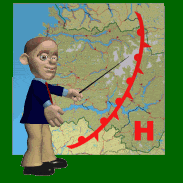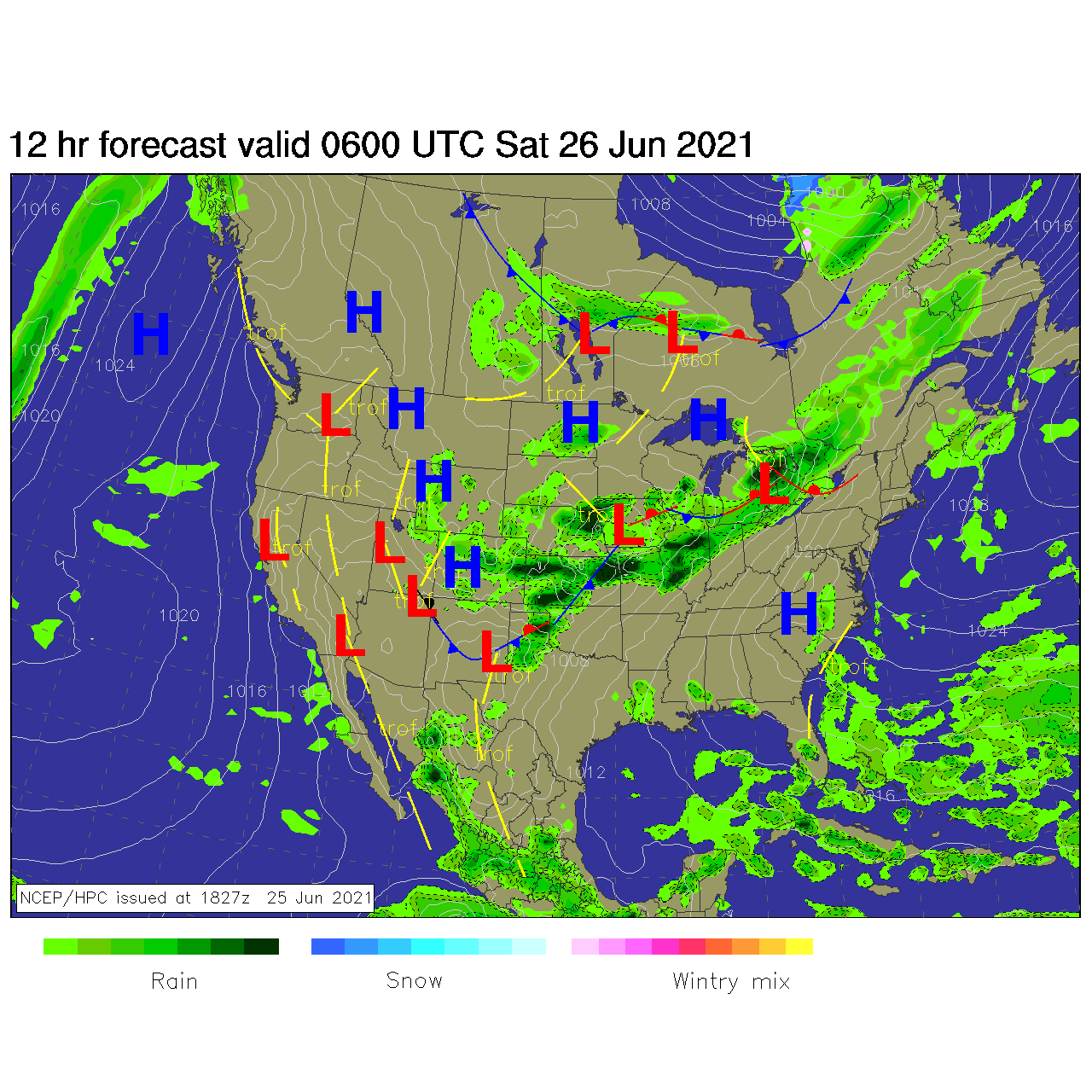Summary
Students follow weather forecasts to gauge their accuracy and produce a weather report for the class. They develop skills of observation, recording and reporting.
Engineering Connection
Engineers must understand global and localized weather patterns for many reasons. Environmental engineers are concerned with weather because it indicates how and when a pollutant may travel. Mechanical, electrical, computer and aerospace engineers must thoroughly understand weather when they design equipment and technology used outdoors or used to predict and measure weather, such as radar, satellites, storm sensors and weather modeling software applications.
Learning Objectives
After this activity, students should be able to:
- Learn how to prepare a weather report based on real-life weather forecasts.
- Apply skills in analysis, synthesis, evaluation and explanation to their writing and speaking.
- Write and speak in the content areas using the technical vocabulary of the subject accurately.
- Use reading, writing, speaking, listening and viewing skills to solve problems and answer questions.
Educational Standards
Each TeachEngineering lesson or activity is correlated to one or more K-12 science,
technology, engineering or math (STEM) educational standards.
All 100,000+ K-12 STEM standards covered in TeachEngineering are collected, maintained and packaged by the Achievement Standards Network (ASN),
a project of D2L (www.achievementstandards.org).
In the ASN, standards are hierarchically structured: first by source; e.g., by state; within source by type; e.g., science or mathematics;
within type by subtype, then by grade, etc.
Each TeachEngineering lesson or activity is correlated to one or more K-12 science, technology, engineering or math (STEM) educational standards.
All 100,000+ K-12 STEM standards covered in TeachEngineering are collected, maintained and packaged by the Achievement Standards Network (ASN), a project of D2L (www.achievementstandards.org).
In the ASN, standards are hierarchically structured: first by source; e.g., by state; within source by type; e.g., science or mathematics; within type by subtype, then by grade, etc.
NGSS: Next Generation Science Standards - Science
| NGSS Performance Expectation | ||
|---|---|---|
|
3-ESS2-1. Represent data in tables and graphical displays to describe typical weather conditions expected during a particular season. (Grade 3) Do you agree with this alignment? |
||
| Click to view other curriculum aligned to this Performance Expectation | ||
| This activity focuses on the following Three Dimensional Learning aspects of NGSS: | ||
| Science & Engineering Practices | Disciplinary Core Ideas | Crosscutting Concepts |
| Represent data in tables and various graphical displays (bar graphs and pictographs) to reveal patterns that indicate relationships. Alignment agreement: | Scientists record patterns of the weather across different times and areas so that they can make predictions about what kind of weather might happen next. Alignment agreement: | Patterns of change can be used to make predictions. Alignment agreement: |
| NGSS Performance Expectation | ||
|---|---|---|
|
MS-ESS2-5. Collect data to provide evidence for how the motions and complex interactions of air masses results in changes in weather conditions. (Grades 6 - 8) Do you agree with this alignment? |
||
| Click to view other curriculum aligned to this Performance Expectation | ||
| This activity focuses on the following Three Dimensional Learning aspects of NGSS: | ||
| Science & Engineering Practices | Disciplinary Core Ideas | Crosscutting Concepts |
| Collect data to produce data to serve as the basis for evidence to answer scientific questions or test design solutions under a range of conditions. Alignment agreement: | The complex patterns of the changes and the movement of water in the atmosphere, determined by winds, landforms, and ocean temperatures and currents, are major determinants of local weather patterns. Alignment agreement: Because these patterns are so complex, weather can only be predicted probabilistically.Alignment agreement: | Cause and effect relationships may be used to predict phenomena in natural or designed systems. Alignment agreement: |
International Technology and Engineering Educators Association - Technology
-
Explain how various relationships can exist between technology and engineering and other content areas.
(Grades
3 -
5)
More Details
Do you agree with this alignment?
State Standards
Colorado - Math
-
Represent and interpret data.
(Grade
5)
More Details
Do you agree with this alignment?
Colorado - Science
-
Describe weather conditions based on data collected using a variety of weather tools
(Grade
5)
More Details
Do you agree with this alignment?
-
Use data collection tools and measuring devices to gather, organize, and analyze data such as temperature, air pressure, wind, and humidity in relation to daily weather conditions
(Grade
5)
More Details
Do you agree with this alignment?
Materials List
Paper and pencils
Worksheets and Attachments
Visit [www.teachengineering.org/activities/view/cub_air_lesson05_activity3] to print or download.Introduction/Motivation
Everybody loves the occasional "snow day." But, can you trust the local weather service to deliver a nice blizzard on cue? Even though weather reporters would like to take credit for good weather and avoid blame for the not-so-good, all they can really do is try to report the weather as accurately as possible. Fortunately, they have advanced technology working for them, such as Doppler radar, satellite imagery and weather forecasting software programs.
With the advent of satellite imaging, Doppler radar and sophisticated weather modeling software, weather forecasting is becoming increasingly accurate. Jokes about the unpredictable nature of weather are still common — "If you don't like the weather around here, wait five minutes!" — but the local meteorologist is not quite as likely to take the blame. If it rains on your parade or picnic, that's probably because you didn't watch the latest weathercast.
In this activity, you are going to take a closer look at how the weather report is delivered in your area. You will keep a record to see how accurate the weather report is. At the same time, you will observe how the report is presented so you can produce a weather show for your class. In the process, you will become better acquainted with weather terminology and learn how the latest weather forecasting technology works.
Procedure
Background
During this activity, students gauge the accuracy of local weather reports for themselves, and at the same time observe the local weather presenter. The goal is to present their own weather report for the class. In the process, students become more familiar with weather terminology (see the Word Origins & Metaphors: Take Their Word for It! literacy activity), learn about how weather forecasting technology works, and develop presentation skills.
If possible, videotape one or more evening weathercasts (4-6PM) and view in class, discussing how the weather is presented. Help the students identify the segments of the broadcast, noting the use of maps and symbols (see Figure 1). Discuss the meaning of weather symbols and basic terminology used by the meteorologist. Critique the style of presentation. The objective is to prepare the students to produce their own weathercast.

Consider taking the students on a field trip to a local television station to see for themselves how a weather report is produced, and meet local weather personalities they have seen on TV.
Observing
Background research: Watch the evening weather report (4-6PM time slot) on your favorite local news channel for one week. Using the Weather Watcher Worksheet, record the forecast for the following day, noting the basic weather forecast description: High and low temperatures, sunny/cloudy, rainy/snowy/windy, chance for precipitation, etc. At the same time, take some notes about the presentation itself. Observe the weather reporter's presentation style. Notice how s/he uses maps and explains weather phenomena for the viewer. Learn the tricks of the trade! The following day, observe the weather and record the actual weather conditions. Was the forecast accurate?
Thinking
Weather reporters love to brag about their Doppler – or Super Doppler or NEXRAD – radar systems. Have you ever wondered what all the hype is about? Learn how the latest tools work: radar, satellite imaging and weather forecasting software (see the References section or search for weather forecasting technology on the Internet).
Writing
Imagine you are presenting the television weather report for the evening news (4-6PM). Prepare your script. Your report should include:
- Today's weather — local, state, national weather maps
- Record high and low temperatures
- Outlook for the evening
- Air quality report including pollution alerts and burning restrictions
- Tomorrow's prediction
- Five-day forecast
- Some interesting weather trivia or an explanation of a weather phenomenon
Create weather maps to use for your report. Make three maps, if possible: one for the local report (city and counties), one for a statewide report and one for the national report (often a satellite image). Make reusable symbols for high and low fronts, as well as cloud, sun, rain, snow and lightning symbols. What other props will you use? An umbrella? Raincoat? Sunglasses? Videotape your presentation if possible.
For extra credit, have students incorporate a lay person-level explanation of Doppler effect or Doppler shift as part of their in-class weather program presentation.
Vocabulary/Definitions
accurate: Exactly factual; errorless.
doppler radar: Radar that uses the Doppler effect to measure velocity of approaching weather.
forecast: To estimate or calculate in advance, especially to predict (weather conditions) by analysis of meteorological data.
front: Meteorology. The interface between air masses of different temperatures or densities.
satellite imagery: Pictures taken by photographic equipment mounted on satellites.
weathercast: A broadcast of weather conditions.
Assessment
Pre-Activity Assessment
Check to make sure students have completed their Weather Watcher Worksheets, both forecasts and actual data.
Activity Embedded Assessment
After introducing students to weather technology, use call-out questions or a pop quiz to reinforce vocabulary and understanding.
Post-Activity Assessment
Depending on the number of students in the class, a different student can deliver the weather forecast each day for a month and be assessed for presentation skills. The shared props for a "Weather Corner" — items such as maps, weather symbols and other graphic images — can be designed and assembled by the class.
Activity Extensions
Play Vivaldi's Baroque masterpiece, The Four Seasons, for the class (see Figure 2). Discuss how the music reflects the qualities of the weather from season to season. Discuss the characteristics of Baroque music. Have students write down their impressions or create a poem, drawing or watercolor to illustrate a season (see Figure 3). Weather and seasonal change are a favorite theme of poets, composers and artists alike. See How Artists See the Weather: Sun, Wind, Snow, Rain by Colleen Carroll.


Activity Scaling
- Creating and presenting an in-class television weather program may be an individual or two-person activity.
Subscribe
Get the inside scoop on all things TeachEngineering such as new site features, curriculum updates, video releases, and more by signing up for our newsletter!More Curriculum Like This

Students consider how weather forecasting plays an important part in their daily lives. They learn about the history of weather forecasting — from old weather proverbs to modern forecasting equipment — and how improvements in weather technology have saved lives by providing advance warning of natura...

Students use their senses to describe the weather and predict it. After learning the basics of weather patterns, students act as state park engineers and design/build backyard weather stations to gather data so they can make real weather forecasts.

Students learn about the remote sensing radio occultation technique and how engineers use it with GPS satellites to monitor and study the Earth's atmospheric activity.
References
Cain, Dennis R. and Kirkwood, Paul. National Weather Service Radar FAQs. Updated March 10, 2004. National Weather Service, NOAA. Accessed July 23, 2004. https://www.weather.gov/jetstream/radarfaq
Carroll, Colleen. How Artists See the Weather: Sun, Wind, Snow, Rain (How Artists See). Abbeville Press, 1996. (A beautiful accompaniment to lessons on figurative language.)
CNN Weather. Updated July 22, 2004. CNN.com. Accessed July 23, 2004. http://www.cnn.com/weather/
Dictionary.com. Lexico Publishing Group, LLC. Accessed July 17, 2004. (Source of vocabulary definitions, with some adaptation) http://www.dictionary.com
Farmer's Almanac. Updated 2003. Alamanac Publishing Co. Accessed July 23, 2004. http://www.farmersalmanac.com
Glossary of Meteorological Terms. NovaLynx Corporation. Accessed July 23, 2004. http://www.novalynx.com/glossary.html
Oates. Language Arts Weather Watch, Teacher Objectives and Rationale. St. James All Grade School, School District 3, Newfoundland, Canada. Accessed July 23, 2004. (Comprehensive language-arts activities focused on the weather theme.) Originally found at: http://projects.sd3.k12.nf.ca/multiage/weather/teacher.html
"See" Inside a Closed Box! (See how radar works). Last updated September 8, 2006. ASA Space Place, National Aeronatucs and Space Administration (NASA). Accessed September 18, 2006. http://spaceplace.nasa.gov/topo-bear/
Seeley, Mark. Weather Talk - Jargon. Updated June 2, 2004. Minnesota Climatology Working Group. Accessed July 23, 2004. (For weather buffs and word lovers, a colorful discussion of weather terminology. Learn what Abraham's Tree, fulgurite, nowcasting, comma clouds and the gustiness factor mean and when to expect the ozone season. Written from a Minnesotan's point of view, but interesting at any latitude.) Originally found at: http://climate.umn.edu/cawap/mpr/jargon.htm
The University Corporation for Atmospheric Research. Updated 2004. UCAR. Accessed July 23, 2004. http://www.ucar.edu/
Watt, Fiona and F. Wilson. Weather and Climate (Science and Experiments Series). E.D.C. Publishing, 1991.
The Weather Channel. The Weather Channel Interactive, Inc. Accessed July 23, 2004. http://www.weather.com
Weather Forecasts & News. USA Today. Accessed July 23, 2004. http://www.usatoday.com/weather/wfront.htm
Real Time Weather Data. National Center for Atmospheric Research. Accessed December 21, 2011. http://weather.rap.ucar.edu/model/
The Weather Underground. Updated 2003. The Weather Underground, Inc.. Accessed July 23, 2004. http://www.wunderground.com/
World Wide Weather, Grades 3-5 science curricula. Updated 2000. International Society for Technology Education (ISTE). Accessed July 23, 2004. (Weather-related activities.) http://cnets.iste.org/students/pdf/3-5WorldWideWeather.pdf
Yamnitz, Kyle. Weather Thematic Unit, Lesson #21. Teachers.net. Accessed July 23, 2004. (Highly recommended resource for literacy activities based on the weather theme; includes detailed bibliography.) http://teachers.net/gazette/JAN02/lessons.html
Copyright
© 2004 by Regents of the University of Colorado.Contributors
Jane Evenson; Malinda Schaefer Zarske; Denise CarlsonSupporting Program
Integrated Teaching and Learning Program, College of Engineering, University of Colorado BoulderAcknowledgements
The contents of this digital library curriculum were developed under a grant from the Fund for the Improvement of Postsecondary Education (FIPSE), U.S. Department of Education and National Science Foundation GK-12 grant no. 0338326. However, these contents do not necessarily represent the policies of the Department of Education or National Science Foundation, and you should not assume endorsement by the federal government.
Last modified: December 13, 2021









User Comments & Tips